CyberPower: 4.0 GHz QX9770 and SLI GTX 280s
by Matt Campbell on August 22, 2008 4:00 AM EST- Posted in
- Systems
Power
We measure power consumption using a Kill-A-Watt device at the wall outlet. Idle indicates a measurement taken in Windows with no applications running. Max indicates the maximum power draw with the system fully loaded (running four instances of Prime95 and 3DMark06 simultaneously). We've also indicated power draw with just the CPU loaded.
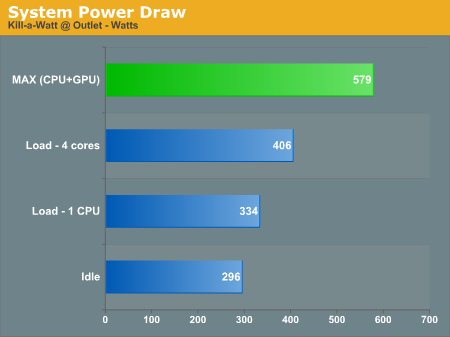
For the hardware present, these results are quite good. Our Tri-SLI system maxed out at 671W, and that only had a single 1200W power supply (versus the 1000Wx2 in this system).
Noise
We measured noise with a sound pressure level (SPL) meter, at distances of 24" and 48". The case fans and video cards dominate the noise produced. For reference, ambient noise was approximately 37.5 dB(A).
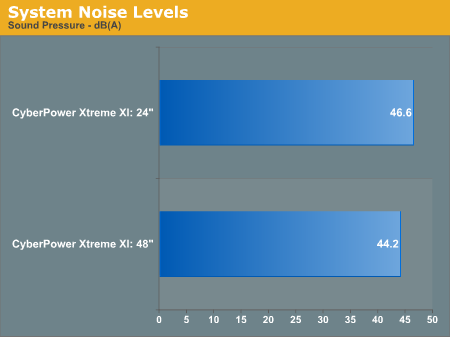
This is a large system, with seven 120mm fans, and even so it manages to remain reasonably quiet. It's definitely audible, but most would find the low hum from the larger fans easy to deal with, and of course the fan controls allow for noise reduction.
Temperature
In most cases, we utilize CoreTemp 0.99 or nTune to measure CPU temperatures. In this case, we also used SpeedFan and the system monitor as additional checks. The NorthQ/Asetek self-enclosed water-cooler (which our friends at FrozenCPU have also provided us for review) is silent and extremely compact for a water cooler, but was registering temps hovering between 50-55C at idle.
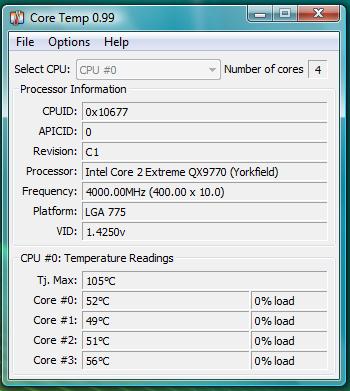
In the System Monitor screenshot, you can see the idle temperature registers at 60C in the BIOS. This seems quite high to us, and load temperatures didn't alleviate our concerns. We wanted to really stress the CPU, so these were taken with four instances of Prime95 running (one assigned to each core).
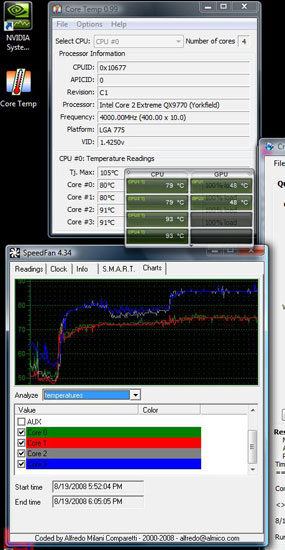 |
Even with a large amount of case circulation, these temperatures are uncomfortably hot. That's not shocking with a 4.0GHz quad-core CPU fully loaded, but there's certainly some concern about long-term stability at these temperatures.
Update: On August 21st, Intel disclosed the maximum TJunction values for their 45nm processor line. As pointed out by readers, the Tj. Max number reported by CoreTemp and NVIDIA's System Monitor was 105C, whereas the official value from Intel for the QX9770 is 85C. Armed with this new information, we first altered the offset in CoreTemp 0.99.1 to bring Tj. Max down to 85 C, and reran the tests at idle and load. We also downloaded the latest version of CoreTemp (0.99.3) with the Tj. Max changes incorporated and measured again at load, reading the same values. This shows the Xtreme XI and the Asetek cooling solution in a much better light.

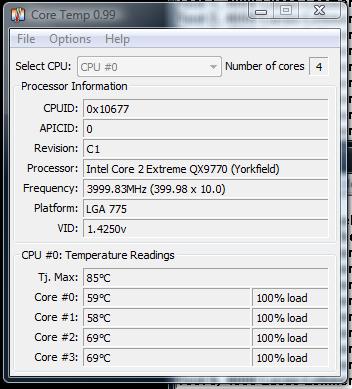
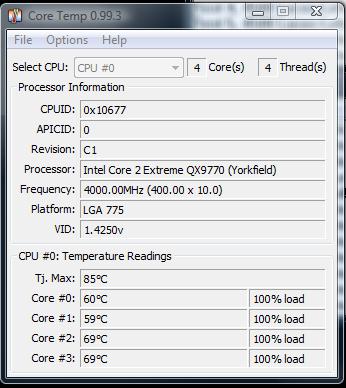










30 Comments
View All Comments
initialised - Saturday, August 30, 2008 - link
To get the most out of the Asetek LCLC we usually fit fans in push-pull. This took a Q9550 at 3.6GHz from 70-75 loaded to 55-60 Loaded. I'm surprised our American cousins hadn't thought to do this. I have a similar system to this under testing right now at 4.2GHz temps not really braking 65, Cosmos-S case though. Having said that, a system with a 4870x2 and 3.8GHz quad is not far behind it in terms of performance. For us Safe & Stable typically means knock the CPU FSB up a notch and XXX means go further on the CPU and OC the RAM and graphics where possible.bob4432 - Sunday, August 24, 2008 - link
w/ your comment - "CyberPower's website comes up immediately from a web search"what did you type into the search engine? and which engine?
2x 1KW....ridiculous as the norm lately....
JarredWalton - Sunday, August 24, 2008 - link
"CyberPower"... Google gives it the number one spot as do MSN and Yahoo. If you put a space in the name, the results aren't changed. Not sure what you would search for that wouldn't have a quick hit.bob4432 - Sunday, August 24, 2008 - link
it is pretty easy to get #1 when you know the name....you need to search w/ stuff other than a direct name, especially the domain name or nearly the domain name, that is a near 100% chance of it being #1. say you don't know the name and you just type in "buy custom online pc" - you get different results.because of this i really wouldn't give them any kudos on their website because a search engine gave them #1 when you typed in almost their domain directly and company name.
getting to #1 for them w/ the way you searched is extremely easy....
Matt Campbell - Sunday, August 24, 2008 - link
Perhaps it is easy, but more than one OEM we've evaluated has *not* come up with a direct web search of their name, which (as you can imagine) makes them quite difficult to locate if you don't know anything else about them.oralpain - Saturday, August 23, 2008 - link
I notice that, in this review, you have CoreTemp calibrated to a TJmax of 105C.According to Intel, the actual TJmax rating of the QX9770 is 85C. Since CoreTemp, and other programs like it, are only capable of measuring the delta to TJmax, proper calibration is critical to knowing actual (load) temperatures.
In your load tests, the CPU only reached into the 70sC, not the 90s.
Source for the TJmax ratings: http://intel.wingateweb.com/US08/published/session...">http://intel.wingateweb.com/US08/publis...sessions...
Matt Campbell - Saturday, August 23, 2008 - link
Thanks for noting this. I did see Kris' update on Thursday as well, here: http://www.anandtech.com/weblog/showpost.aspx?i=47...">http://www.anandtech.com/weblog/showpost.aspx?i=47..., which finally gives us solidified TJmax numbers to work with. As this was just made public information on the 21st, however, the article had already been sent in for publication. I will re-run the test and post the results.brian_riendeau - Friday, August 22, 2008 - link
"The cooling is sufficient I think, for everywhere except perhaps the CPU. I'd wager that an Ultra-120 eXtreme would beat it, but that's just a guess. As for the rest of the comments, while two PSUs is certainly overkill for this particular configuration, doubling the RAM will hardly have an impact on most things. I've got a 4GB system and a 2GB system (64-bit and 32-bit), with similar parts elsewhere. Unless I really open a LOT of applications (and 32-bit ones at that, since there are very few 64-bit apps), I couldn't tell them apart."and from the review...
"they took an extra step in integrating them into a solution with reasonable component choices that worked well together and provided a stable operating platform"
Fact is with Vista SuperFetch preloading commonly used files into RAM during idle times, the performance benefits of extra RAM really start to pay off even as you go over 4GB. With 8GB of RAM, it will cache up most of the games you typically play bringing launch times and level switch times down dramatically. This is the type of thing that has a huge difference in the real world feel, but rarely shows in benchmarking. Given the minimal cost of another 4GB of RAM and the system going over $5.5K in cost, I think its ridiculous for this system not to come with 8GB of RAM from the start.
JarredWalton - Friday, August 22, 2008 - link
The problem is that most games are now well over 4GB, and the data they use is so variable (one level uses a certain 1GB, the next level uses a different 1GB, etc.) If you surf the web a lot, run your email app, Word, Excel, and play several different games, SuperFetch gets overwhelmed.But you know what? All that is beside the point! You want 4x2GB RAM? It's an option. You want a case with one PSU? They've got that too. That's why this is a review of both a specific PC (the Gamer Extreme XI) plus plenty of commentary on CyberPower as a whole. You want a different config? How about this, which is probably what I would go with for high-end right now:
Gamer Infinity 8900 Deluxe
--------------------------
CoolerMaster Centurion 590 RC-590 Mid-Tower Case
3 extra case fans
Thermaltake ToughPower 1,000W PSU
Core 2 Quad Q9550
Thermaltake Big Typhoon VX
GigaByte GA-EP45T-DS3R
4x2GB DDR3-1333 ("Major brand")
ATI Radeon HD 4870X2 (Feel free to add a second)
300GB Western Digital Raptor
1TB 32MB 7200RPM HDD
LG GGC-H20L BLU-RAY/HD-DVD Reader/DVD±R/±RW Writer
(Onboard audio and network)
Logitech Wave Keyboard
Razer Diamondback 3G Blue Mouse
12-in-1 Flash reader
Vista Ultimate 64-bit
3-year warranty
Total CyberPower cost: $3057 + shipping and tax
CoolerMaster Centurion 590 RC-590 $65
3 x 120mm case fans $12
Thermaltake ToughPower 1,000W PSU $310
Core 2 Quad Q9550 $330
Thermaltake Big Typhoon VX $53
GigaByte GA-EP45T-DS3R $160
4x2GB Patriot DDR3-1333 $358
PowerColor Radeon HD 4870X2 $560
300GB Western Digital Raptor $295
SAMSUNG Spinpoint F1 HD103UJ 1TB 7200 RPM 32MB $150
LG GGC-H20L $150
Logitech Wave Keyboard $50
Razer Diamondback 3G Blue Mouse $50
12-in-1 Flash reader $20
Vista Ultimate 64-bit (OEM) $180
Warranty ???
Total for parts purchased at Newegg: $2,743
(Tax and shipping also missing.)
$300 for an extra 2-year warranty, plus assembly and testing, and shipping is likely to be less than the individual parts. Again, the comparison is quite favorable.
HanSolo71 - Friday, August 22, 2008 - link
in your previous rig you said you had a Q6600 @ 3.3 Ghz and SLI 3870's how can you have SLI ATI cards?